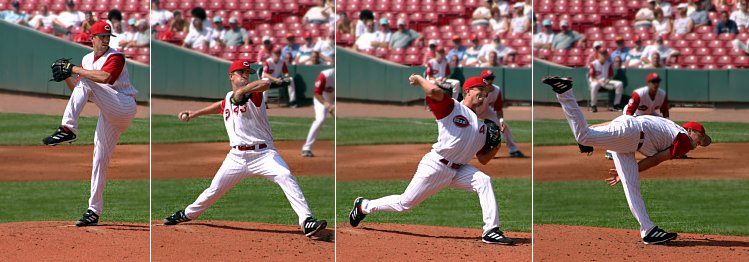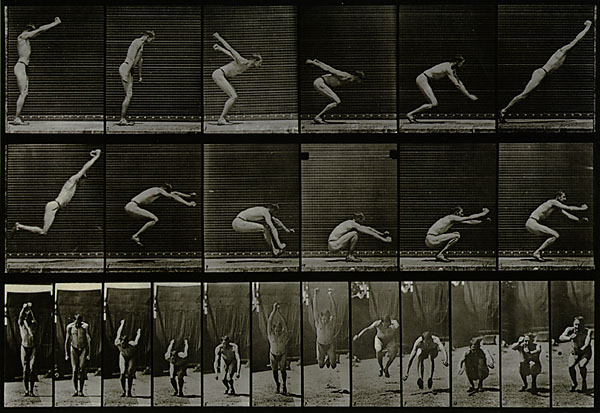Module 7 - Anticipation
Overview
Anticipation is used to prepare the audience for an action, and to make the action appear more realistic. A dancer jumping off the floor has to bend his knees first; a golfer making a swing has to swing the club back first. The technique can also be used for less physical actions, such as a character looking off-screen to anticipate someone's arrival, or attention focusing on an object that a character is about to pick up.
Physical Anticipation
Most natural actions require noticeable anticipation to be physically possible to achieve.
One example can be easily seen when we you jump. Try to jump without crouching down at all and keeping your body still with arms at your sides. The extent of height you will be able to achieve is limited solely to the energy the balls of your feet can muster. My guess is that the maximum height you will be able to achieve is maybe an inch or two if that. Now remove all of your restrictions and attempt to jump as high as you can vertically. Everything you are doing naturally with this jump is anticipation. One of the main things you do is crouch down. This is the most obvious anticipation for a jump but if you remember from our discussion about arcs last week you will remember that our bodies again want to minimize the amount of energy it uses to perform an action and in the occasion where that action requires maximum energy output that means it is going to focus all of its energy into that task which will involve every part of your body. This involves your head, back, legs, arms, fingers, nose, tongue, liver... EVERYTHING! Okay well maybe not as much the last few, but the important thing is that either a body part is helping the cause or it is in the way.
A pro basketball player will train for their entire career to hone each part of their body to remove resistance and exert the energy into the jump to maximize height reached. Everything that happens prior to the action is what enables that action to be possible. First crouch down into a ball and gain as much power and momentum as you can before you explode out of the ball and jump as far and as high as you can. This is called anticipation, and as animators we use anticipation to not only mimic what happens in real life, but also to communicate to our audience what is about to happen.
If we didn't crouch into a ball before we jumped into the air, we would appear to just float off the ground as if we were riding an escalator.
Think of a pitcher in Baseball. Before each pitch, they go through a wind up. This is anticipation. If we see someone go through this process, we will expect that the person is about to throw a ball.
In most cases, the anticipation of an action will actually go in the opposite direction of the action that it is anticipating. For example, let's look at the pitcher we were just talking about:
 Click on the image to view full screen
Click on the image to view full screen
In the first frame of the action, we see the pitcher lean back to screen left, his arms move back and so does his chest. He lifts his leg way up toward his chest. The very next frame we see his leg move in the complete opposite direction as he throws it forward to take a huge step and gather momentum for his throw. Next we see his chest and arm move forward as he brings his whole body down the pitchers mound. Each action he performs prior to the forward motion is anticipation for the throw. However, some of the anticipation still continues into the forward motion to maximize the speed of the pitch. Look how his arm extends back in frame two even though he is already starting his forward motion with his body. Overlapping action anyone?!? In this case the pitcher uses the anticipation to store up the energy and uses overlapping action to increase the energy as he propel the ball forward.
Sometimes analyzing something like a jump can be harder to see because we are all so familiar with jumping that you might forget that you have to gather energy first. It becomes second nature to us.
 Click on the image to view full screen
Click on the image to view full screen
We can clearly see how important the anticipation is. The first 4 frames are all anticipation for the 5th frame which is the fully extended frame of the jumpers body with all energy having been put into this pose. Everything else is the jumper pulling his body forward to jump as far forward as he can.
As you explore anticipation in your assignment this week. Think about how it is communicating to your audience.
Artistic Anticipation
While physical anticipation is most of what you are going to be focusing on with animation there are artistic considerations that should always be on your mind. Both Good and Bad.
What to do!
Remember that every action your character performs should support the directional point of the shot. Even if it is an action shot with no dialogue you need the animation to support the characters overall makeup at that time in the greater picture. Is the character tired, angry, happy, frustrated, sick? What happened in the shots and scenes that lead up to the shot you are working on? Where is the character heading in future shots? Is the character interacting with other characters in the scene? What are they doing? How is your character reacting to what they are doing?
If a character is depressed then their anticipation to their reaction to someone entering the scene who is happy with full of energy is going to be very different than someone who is also happy reacting to the same energetic character. At least it should if you really want your audience to believe that the depressed character is actually depressed. Let's investigate some anticipation here that isn't necessarily physical, but artistic.
Your character is a father-to-be sitting in the waiting room of a hospital waiting to hear the diagnosis of his pregnant wife who was just whisked away to surgery because of complications during child-birth. What is his posture like just moments before the door opens? What is the rest of his body doing? Is he sitting very still and quiet or is he pacing the room? When that door opens does he slowly turn his head toward the door without his posture really changing or does he jump up and almost rush the doctor to literally suck the news out of him as fast as possible? How about before the door opens? Does the father keeping looking back and forth between a clock on the wall and the door? Is he nervously thumbing through a magazine trying to pass the time? All of this stuff is artistic anticipation to bring the audience into the feelings of the character so that we want that door to open with good news just as much as he does.
What not to do!
There are times when the presence of anticipation can be bad from a physical or artistic standpoint and that is when it occurs with the wrong timing or the wrong emphasis. This usually occurs in acting or animation acting when a character knows whats coming in the scene (And an actor usually should because its pre-written and rehearsed) and it shows in their reaction. Here is a good article on this topic. An example of this might be starting to duck a surprise punch too soon, or starting to look sad too quickly before the delivery of bad news is fully complete. You as an animator will know every bit about whats coming in the scene including the exact timing of the actions and dialogue because you are creating it. So be careful to ensure you focus on good timing whether it is actions or dialogue or both.
To wrap it up.
Learning these skills is all about film-making, storytelling and cinematography. While you can be a decent animator without these skills you will never be a fantastic animator without them. Your job as an animator is to make your character do exactly what it should do to support the story. If your animation doesn't do that then you have failed even if you have everything physically and technically accurate.
Assignment
Flour Sack Jump I
This will be the first of two assignments that run for 2 weeks each. This week and next You will be animating a flour sack doing a simple forward jump. We are just focusing on the quality of the anticipation, timing and posing of the character throughout the jump. Don't do anything fun or fancy with the beginning or end just do the physical jump and everything that supports that
Our flour sack is not in a good mood or in a bad mood. He is having an average day and he has decided he is going to go out for the track team next year when he starts high school and isn't sure how good his jump is. He has setup a camera to take some video reference of himself doing a single jump and is going to analyze it.
- Think about the shot you are going to be animating. Close your eyes and think about what actions you are going to be performing.
- Get up out of your chair and act it out. Do a few jumps to feel the motion in your body. Then stop yourself at different points in the jump and analyze your pose. Where are your arms? How is your body positioned? Where is your head?
- Do some sketches of your bodies position at those different maximum poses throughout the jump
- Get a camera and shoot some video reference of your jump.
- Analyze your jump frame by frame to see how that compares to your impressions of the poses you sketched out earlier
- Create your official key frame thumbnails for the jump as well as the path of action your characters center of gravity will be following.
- Now you can get working in Maya. Download the flour sack character rig file from this page
- Open the character rig and familiarize yourself with all of the controls. Pose the character and play with it to see what works and what doesn't
- Move your shot_cam to an angle that allows for us to see the action throughout yet emphasizes the emotion of the shot. A nice side angled wide shot would be a good choice
- Begin your official animation by working through the blocking of the animation using your thumbnails and video reference as guides
- Spline your keys and begin refining the curve tangents and adjusting timing and spacing as needed until your jump has all of the anticipation and motion solidly displayed.
- Get some feedback about your animation and continue polishing until you can't do anything more
- Get some more feedback and keep polishing
Remember to include every part to emphasize the jump including the tied end corners.
Once complete submit your final playblast MP4 video to Assignment 7 on UNM Canvas
-
Class Lecture
Attend Class Lecture -
Class Instruction
Review Module Written & Video Material -
Discussion
Anticipation -
Lab & Exercises